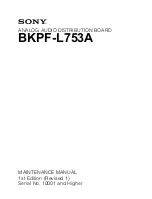
OPTIMOD-PC INTRODUCTION
1-27
Unless the path is a digital path using no lossy compression, this situation will yield
lower performance than if OPTIMOD-PC is connected directly to the transmitter be-
cause artifacts that cannot be controlled by OPTIMOD-PC will be introduced by the
link to the transmitter. These artifacts can decrease average modulation by 2-4dB
and can also add noise and audible non-linear distortion. In the case of lossy digital
compression, this deterioration will be directly related to the bitrate. For an analog
path, the deterioration will depend on the amount of linear and non-linear distor-
tion in the path. In addition, there will be an unavoidable amount of overshoot
caused by asynchronous re-sampling (see page 1-24).
One strategy is to apply to OPTIMOD-PC’s output signal the same lossy compression
that the DAB transmitter would apply. If a digital link is available with sufficient bi-
trate to pass this compressed signal, it can then be passed directly to the DAB trans-
mitter without further processing if synchronization issues can be resolved. Consult
with the manufacturer of your DAB transmitter to see if this can be done.
Where only an analog or lossy digital link is available, feed the audio output of
OPTIMOD-PC directly into the link. If available, the transmitter’s protection limiter
should be adjusted so that audio is normally just below the threshold of limiting:
The transmitter protection limiter should respond only to signals caused by faults or
by spurious peaks introduced by imperfections in the link.
Where maximum quality is desired, it is wise to request that all equipment in the
signal path after the studio be carefully measured, aligned, and qualified to meet
the appropriate standards for bandwidth, distortion group delay and gain stability.
Such equipment should be measured at reasonable intervals.
OPTIMOD-PC at the Transmitter: Gain Control before the STL
The audio received at OPTIMOD-PC’s input should have the highest possible quality.
To achieve the full audible benefit of OPTIMOD-PC processing, use a studio-
transmitter link (STL) that is as flat as the bandwidth of OPTIMOD-PC as used in your
facility (usually 20 kHz). Ideally, you should use a 20-bit (or better) uncompressed
digital link with at least 44.1 kHz sample frequency.
Because the audio processor controls peaks, it is not important that the audio link
feeding OPTIMOD-PC’s input terminals be phase-linear. However, the link should
have low noise, the flattest possible frequency response from 20-20,000Hz, and low
non-linear distortion.
If the audio link between the studio and the transmitter is noisy (or, if digital, is lim-
ited to 16 bits or less), performing the AGC function at the studio site can minimize
the audibility of this noise. AGC applied before the audio link improves the signal-
to-noise ratio because the average level on the link will be greater. Further, many
STLs require level control to prevent the STL from being overloaded.
To apply such level control and compression, we recommend an Orban
AGC/Limiter/HF Limiter/Clipper before the STL transmitter. This performs the func-
tion of OPTIMOD-PC’s internal broadband automatic gain control (AGC), while si-
multaneously protecting the STL. If this is done, defeat OPTIMOD-PC’s broadband
















































